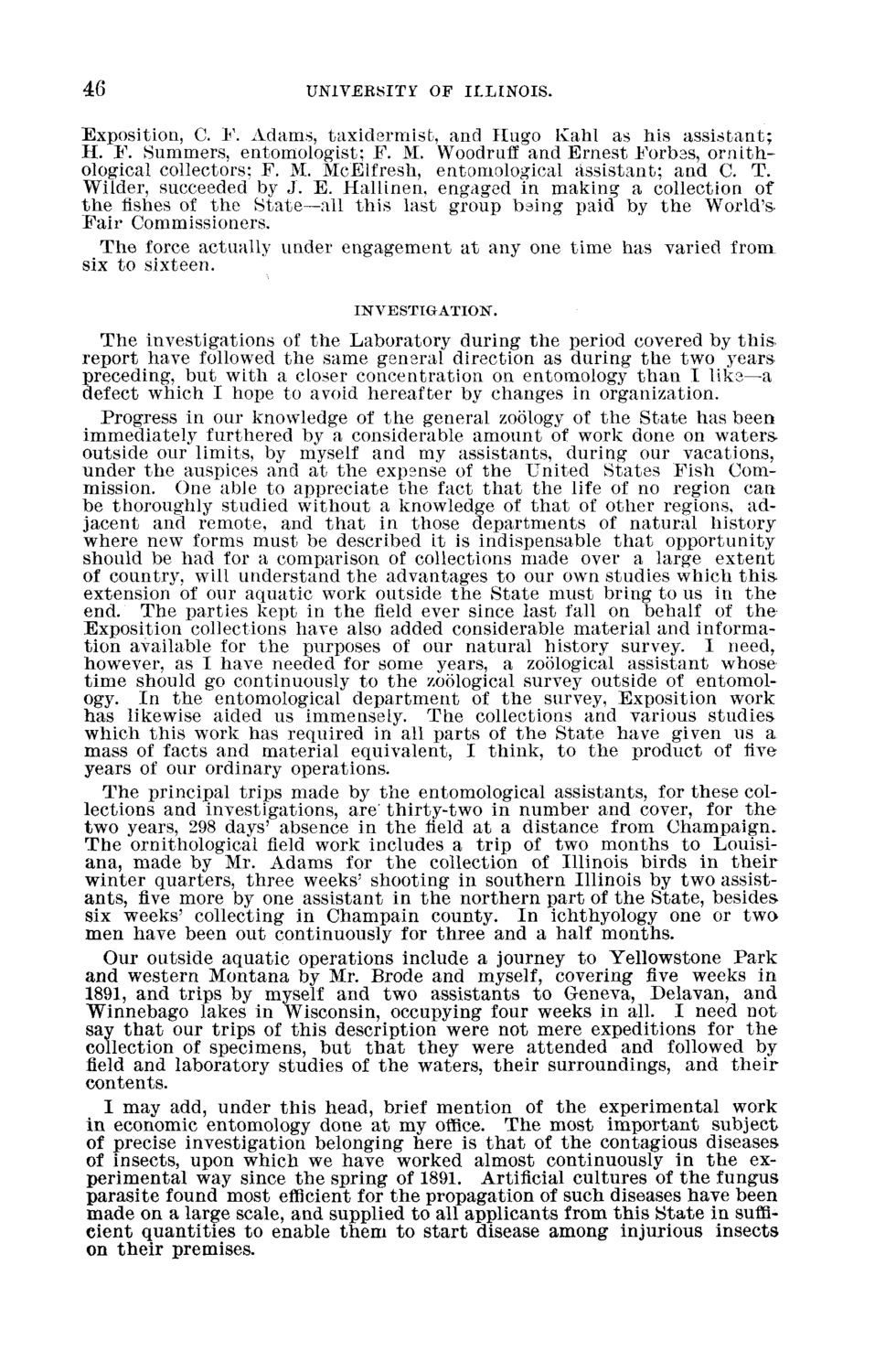| |
| |
Caption: Board of Trustees Minutes - 1894
This is a reduced-resolution page image for fast online browsing.

EXTRACTED TEXT FROM PAGE:
46 UNIVERSITY OF ILLINOIS. Exposition, C. F. Adams, taxidermist, and Hugo Kahl as his assistant; H. F. Summers, entomologist; F. M. Woodruff and Ernest Forbes, ornithological collectors: F. M. McElfresh, entomological assistant; and C. T. Wilder, succeeded by J. E. Hallinen, engaged in making a collection of t h e fishes of the State—all this last group being paid by t h e World's Fair Commissioners. The force actually under engagement at any one time has varied from six to sixteen. INVESTIGATION. The investigations of the Laboratory during the period covered by t h i s report have followed the same general direction as during the two years preceding, but with a closer concentration on entomology t h a n I like—a defect which I hope to avoid hereafter by changes in organization. Progress in our knowledge of the general zoology of the State has been immediately furthered by a considerable amount of work done on waters, outside our limits, by myself and my assistants, during our vacations, under the auspices and at the expense of the United States Fish Commission. One able to appreciate the fact t h a t the life of no region can be thoroughly studied without a knowledge of t h a t of other regions, adjacent and remote, and t h a t in those departments of natural history where new forms must be described it is indispensable t h a t opportunity should be had for a comparison of collections made over a large extent of country, will understand the advantages to our own studies which t h i s extension of our aquatic work outside the State must bring to us in t h e end. The parties kept in t h e field ever since last fall on behalf of t h e Exposition collections have also added considerable material and information available for the purposes of our natural history survey. I need, however, as I have needed for some years, a zoological assistant whose time should go continuously to the zoological survey outside of entomology. In the entomological department of the survey, Exposition work has likewise aided us immensely. The collections and various studies which this work has required in all parts of t h e State have given us a mass of facts and material equivalent, I think, to the product of five years of our ordinary operations. The principal trips made by the entomological assistants, for these collections and investigations, are thirty-two in number and cover, for t h e two years, 298 days' absence in the field at a distance from Champaign. The ornithological field work includes a trip of two months to Louisiana, made by Mr. Adams for t h e collection of Illinois birds in t h e i r winter quarters, three weeks' shooting in southern Illinois by two assistants, five more by one assistant in t h e northern part of the State, besides six weeks' collecting in Champain county. In ichthyology one or twomen have been out continuously for three and a half months. Our outside aquatic operations include a journey to Yellowstone Park and western Montana by Mr. Brode and myself, covering five weeks in 1891, and trips by myself and two assistants to Geneva, Delavan, and Winnebago lakes in Wisconsin, occupying four weeks in all. I need not say t h a t our trips of this description were not mere expeditions for t h e collection of specimens, but t h a t they were attended and followed by field and laboratory studies of the waters, their surroundings, and t h e i r contents. I may add, under this head, brief mention of the experimental work in economic entomology done at my office. The most important subject of precise investigation belonging here is t h a t of the contagious diseases of insects, upon which we have worked almost continuously in t h e experimental way since the spring of 1891. Artificial cultures of the fungus parasite found most efficient for the propagation of such diseases have been made on a large scale, and supplied to all applicants from this State in sufficient quantities to enable them to start disease among injurious insects on their premises.
| |